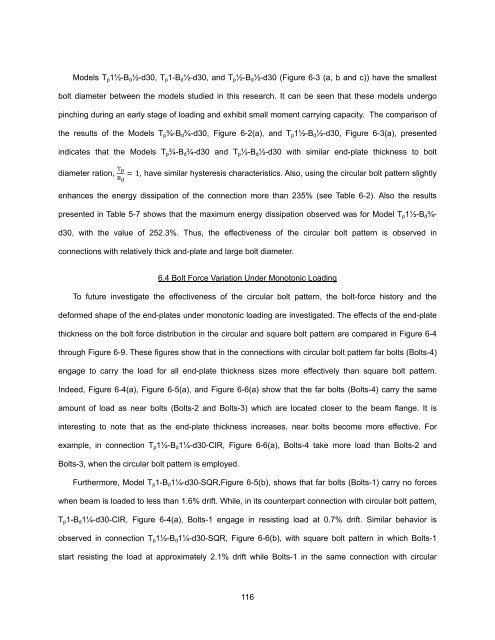ON THE EFFECTS OF CIRCULAR BOLT PATTERNS ON THE ...
ON THE EFFECTS OF CIRCULAR BOLT PATTERNS ON THE ...
ON THE EFFECTS OF CIRCULAR BOLT PATTERNS ON THE ...
Create successful ePaper yourself
Turn your PDF publications into a flip-book with our unique Google optimized e-Paper software.
Models Tp1½-Bd½-d30, Tp1-Bd½-d30, and Tp½-Bd½-d30 (Figure 6-3 (a, b and c)) have the smallest<br />
bolt diameter between the models studied in this research. It can be seen that these models undergo<br />
pinching during an early stage of loading and exhibit small moment carrying capacity. The comparison of<br />
the results of the Models Tp¾-Bd¾-d30, Figure 6-2(a), and Tp1½-Bd½-d30, Figure 6-3(a), presented<br />
indicates that the Models Tp¾-Bd¾-d30 and Tp½-Bd½-d30 with similar end-plate thickness to bolt<br />
diameter ration, T<br />
1, have similar hysteresis characteristics. Also, using the circular bolt pattern slightly<br />
B enhances the energy dissipation of the connection more than 235% (see Table 6-2). Also the results<br />
presented in Table 5-7 shows that the maximum energy dissipation observed was for Model Tp1½-Bd¾-<br />
d30, with the value of 252.3%. Thus, the effectiveness of the circular bolt pattern is observed in<br />
connections with relatively thick and-plate and large bolt diameter.<br />
6.4 Bolt Force Variation Under Monotonic Loading<br />
To future investigate the effectiveness of the circular bolt pattern, the bolt-force history and the<br />
deformed shape of the end-plates under monotonic loading are investigated. The effects of the end-plate<br />
thickness on the bolt force distribution in the circular and square bolt pattern are compared in Figure 6-4<br />
through Figure 6-9. These figures show that in the connections with circular bolt pattern far bolts (Bolts-4)<br />
engage to carry the load for all end-plate thickness sizes more effectively than square bolt pattern.<br />
Indeed, Figure 6-4(a), Figure 6-5(a), and Figure 6-6(a) show that the far bolts (Bolts-4) carry the same<br />
amount of load as near bolts (Bolts-2 and Bolts-3) which are located closer to the beam flange. It is<br />
interesting to note that as the end-plate thickness increases, near bolts become more effective. For<br />
example, in connection Tp1½-Bd1¼-d30-CIR, Figure 6-6(a), Bolts-4 take more load than Bolts-2 and<br />
Bolts-3, when the circular bolt pattern is employed.<br />
Furthermore, Model Tp1-Bd1¼-d30-SQR,Figure 6-5(b), shows that far bolts (Bolts-1) carry no forces<br />
when beam is loaded to less than 1.6% drift. While, in its counterpart connection with circular bolt pattern,<br />
Tp1-Bd1¼-d30-CIR, Figure 6-4(a), Bolts-1 engage in resisting load at 0.7% drift. Similar behavior is<br />
observed in connection Tp1½-Bd1¼-d30-SQR, Figure 6-6(b), with square bolt pattern in which Bolts-1<br />
start resisting the load at approximately 2.1% drift while Bolts-1 in the same connection with circular<br />
116
















